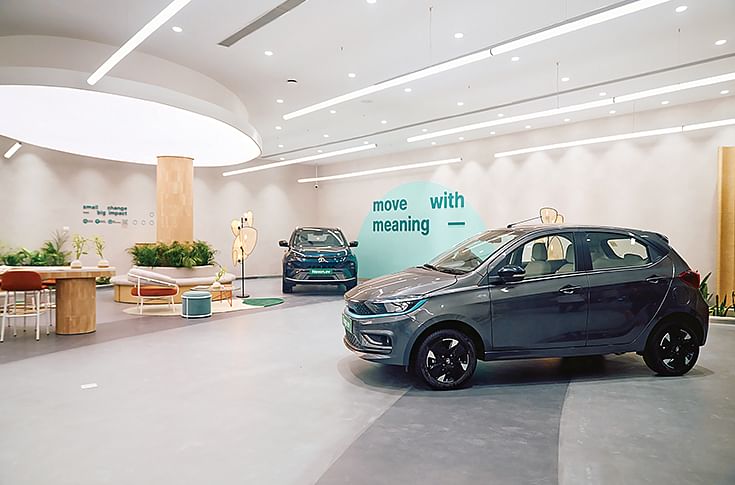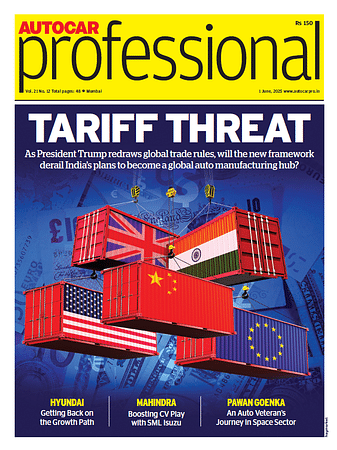‘At Tata Motors, we are designing an experience’: Martin Uhlarik
Tata Motors has recently switched to a completely new retail channel and brand identity for its EVs. The company's VP and Head of Design, Martin Uhlarik says the design team helped conceptualise the exclusive retail spaces that are in line with its core design philosophies.
How do you perceive design, and what are the guiding principles for design at Tata Motors?
A good design is about being responsible, and being understandable. It must appeal to the customer almost immediately as they see it. They should not need to process it much, unlike art, which sometimes tends to strike a contrarian opinion at first, and gradually starts looking insightful and starts making sense.
Automotive design, on the other hand, is an applied art, and caters to a business. Therefore, we must ensure that the vehicle appeals to the customers within the first 3-5 seconds. Having said that,it must be beautiful, and timeless. As we are focusing on sustainability, design must age gracefully, and it should not just induce a short-term wow factor, and aim to only be fashionable. While every design will eventually age, at the same time, we must ensure it ages gracefully.
At Tata Motors, we have a design guide book that encompasses design directions for all our passenger car products, EVs, Avinya products, as well as commercial vehicles, as all of them fall under the overarching umbrella of the Tata Motors' design department, despite each having their own individual character.
The design guide book is like a manifesto, and the enlisted philosophies could be applied to a vehicle’s exterior, interior, UX/UI, retail, and brand, among other things. And occasionally, we have a product, which is the latest version of this manifesto. The design guide book has a shelf life of 3-5 years, and it keeps evolving.
Was the Tata Motors' design team involved in the conceptualisation of the new EV-only retail stores?
The design team is a key shareholder in the company's transformation, as not only are we designing the product, but also the experience. Design, therefore, is a very cross-functional team within Tata Motors, and it now has dedicated brand designers who are focused on designing the entire ecosystem around our products.
 Tata Motors' new and state-of-the-art standalone outlets for its .ev products are designed to offer consumers and prospects an immersive brand experience.
Tata Motors' new and state-of-the-art standalone outlets for its .ev products are designed to offer consumers and prospects an immersive brand experience.
Along with the marketing team, we have been involved in the retail design, as well as the design of our product website, and configuration to ensure that everything across the brand communication remains consistent. That is important for building the confidence in a new EV sub-brand. In terms of the new dedicated EV stores, we started by defining our brand values.
We have certain design principles related to the colours, surfaces, materials, and philosophies, internally, and we use them as the starting point for coming up with a new design. We then evaluate the proposals to ensure consistency in Tata Motors' overall design messaging.
Design, as a discipline, has the sensitivity to think about the customer's reaction to a change, and, being designers, it is our job to solve such problems, and understand their emotions. While the vehicle aesthetics, and interior are the traditional things in our consideration set, one must also get into the psychology of EV customers to understand their expectations from our products. Therefore, designing an experience is key, and that is what we are involved in, at Tata Motors.
How are you witnessing automotive design evolve with Electric Vehicles?
With EVs, the level of design is becoming very high, whether the company is a legacy player with a rich heritage, or a young startup. The quality of their presentation and design is right up there. Having said that, there is also a certain anonymity and blandness that is emerging as a pattern with EV design.
For instance, the side profiles of several EVs largely resemble each other, and they are all following the same recipe even on the vehicle interior.
While EVs are already challenging the mobility landscape, I am worried about the product becoming a commodity, like the mobile phone, which we have started taking for granted now.
On the other hand, the automobile, over the last 100 years, has had a very special place, as a consumer product in reflecting one's personality, dreams, values, and aspirations. However, if it now becomes just a commodity that we utilise to go from point A to B in a safe, comfortable, and sustainable manner, the companies that crack the code, and manage to add a layer of personality, identity, and passion, and get people excited about the product, are the ones to have an edge over others.
Given that electric vehicles are essentially software on wheels, and their driving experience is also passive, this is extremely challenging puzzle to solve. While such designs might be enough for most of the consumers, there is a percentage of buyers looking for a memorable experience. We are conscious of the fact that this trend is underway, and it would be fascinating to see how the industry and market evolves.
How are you leveraging advanced technology in the design process?
We have several technological tools that we are using in the design process. For instance, we are just beginning to play with AI, and do not see it as a threat or replacement. It is about being comfortable with it as it gives us the opportunity to see more proposals faster. It is very important to input the right prompts, as well as in being selective in choosing the right outputs.
We are also using virtual reality or VR across our three studios in India, Italy, and the UK. We use VR and XR (extended reality) to collaboratively review, for instance, a design sketch in the same meta-space, and have discussions about it. This allows us to make changes quickly, and therefore, everything is just getting faster with some of these modern tools.
What is a better approach to design – form-follows-function – or is it the other way around?
Good design is pure and there should not be anything superficial about it. It must be like nature, which is not styled, but is engineered. Therefore, it is all the hard points that are part of the design, and must be engineered first into the vehicle platform, followed by the styling and beautification aspects, to make the product look good. So, I would say that car design must always adopt a form-follows-function approach.
A vehicle architecture is not just done by the engineering team, but the design team works in tandem to give packages in terms of the right proportion, and ergonomic models that evaluate aspects such as vehicle ingress, egress, visibility, and how the mass sits together in terms of the exterior proportions. We create this canvas collaboratively, and once the hard points are properly defined, then the vehicle styling begins.
The design team visualises the vehicle to make a full-sized proportion model which is typically made of foam, and has its windows painted black, while the body remains white. This allows us to evaluate its visual appeal, and we look at this model with the engineering team to ascertain whether it looks front heavy, rear heavy, or over- or under bodied, and then change the wheel track or wheelbase to make it visually proportionate.
Same goes for the vehicle interior, which must perform from a functional aspect of ease of ingress, egress, visibility outside, sense of space, and ease of use. All these aspects combined count as a proper design and should not be an afterthought.
This interview was first published in Autocar Professional's March 1, 2024 issue.
RELATED ARTICLES
'No Question of Us Being Late' - Suzuki India on e-2Wheeler Market
Suzuki Motorcycle India believes its EV entry is timely as the market is now mature enough to grow off genuine demand ra...
'India Can Become a Major Pillar for Us' - Marquardt Group
Björn Twiehaus, CEO of Marquardt Group, and Vishal Narvekar, the company's India GM, share their outlook on the Indian m...
Luxury Car Market to Slow in 2025: Mercedes-Benz Sees Flattish Numbers
In Jan to March of 2025, the market may witness its slowest growth since COVID-19, and if the weakness continues, the se...





 17 Mar 2024
17 Mar 2024
 16909 Views
16909 Views





 Angitha Suresh
Angitha Suresh


 Darshan Nakhwa
Darshan Nakhwa

 Prerna Lidhoo
Prerna Lidhoo

